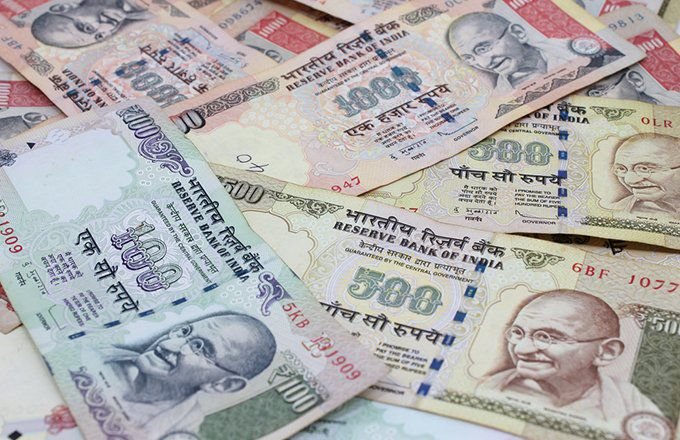- What Is Currency Convertibility?
- The State of the Indian Rupee
- Full convertibility would mean the rupee exchange rate would be left to market factors without any regulatory intervention. There would be no limit on inflow or outflow of capital for various purposes including investments, remittances, or asset purchases/sales. Types of Convertibility for the Rupee Any currency may be current account convertible, capital account convertible, or both. The rupee is partially convertible because it is current account convertible but not capital account convertible. Current Account Convertibility
- Capital Account Convertibility
- Advantages and Disadvantages of a Fully Convertible Rupee
- Advantages
- The growing international interest in the Indian rupee is evident from the development of offshore rupee markets in locations like Dubai, London, New York, and Singapore. Trading of the INR is still far lower than other currencies such as the euro. As of September 2024, INR contracts traded against the dollar an average of 11,825 times per day in 2024, compared to 198,027 contracts converted from Euro to USD. Disadvantages
- Conditions for a Fully Convertible Indian Rupee
- What Is the Currency of India?
- Is the Indian Rupee Fully Convertible?
- When Will the Indian Rupee Become Convertible?
- The Bottom Line
India’s currency, the rupee, is not yet a fully convertible currency, meaning there are still restrictions that make it difficult to buy or sell in the foreign exchange (forex) market. However, there have been talks of making the rupee (INR) fully convertible and setting up an onshore INR market.
India has taken several steps to alter some of its standardized currency policies including demonetization. As India gains economic power and broadens foreign investment collaboration, there are both advantages and disadvantages associated with rupee convertibility which have led to a continuous debate since reforms were first introduced during the early 1990s.
Key Takeaways
- Convertibility is the ease with which a country’s currency can be converted into gold or another currency through global exchanges.
- India’s rupee is a partially convertible currency, meaning rupees can be exchanged at market rates in some cases but larger amounts require approval.
- A fully convertible rupee would increase liquidity in financial markets, improve employment and business opportunities, and create easier access to capital.
- Disadvantages of a fully convertible rupee include higher volatility, an increased burden of foreign debt, and an effect on the balance of trade and exports.
What Is Currency Convertibility?
Convertibility is the ease with which a country’s currency can be converted into gold or another currency through global exchanges. It indicates the extent to which the regulations allow inflow and outflow of capital to and from the country.
Currencies that aren’t fully convertible are generally difficult to convert into other currencies. These currencies are usually more tightly controlled by a government’s regulatory authority or central bank.
Currency convertibility is an important part of global commerce because it opens up trade with other countries. Having a convertible currency allows a government to pay for goods and services in a currency other than its own. Having a nonconvertible currency makes it harder for a government to participate in the international market because these transactions generally take longer to execute.
A nation’s economy may be related to whether its currency is convertible. Stronger currencies tend to be converted more easily than others, while growth may be stagnant for currencies with poor convertibility because these countries may miss trade opportunities.
The State of the Indian Rupee
Until the early 1990s (pre-reform period), anyone using rupees who wanted to transact in a foreign currency would need permission from the Reserve Bank of India (RBI), regardless of the purpose. These transactions included things like:
- Foreign travel
- Foreign studies
- Purchasing imported goods
- Receiving foreign currencies (such as with exports) and exchanging them for cash
These types of transactions had to go through the RBI. All such forex exchanges occurred at pre-determined forex rates finalized by the RBI.
In 1992, liberal economic reforms were introduced that impacted the way forex transactions were conducted. Exporters and importers could exchange foreign currencies for the trade of unbanned goods and services. There was easy access to forex for studying or traveling abroad, and, depending on the industry, there were fewer restrictions on foreign business and investments.
However, Indians still require regulatory approval if they want to invest an amount above a pre-determined threshold in overseas assets. Similarly, incoming foreign investments in certain sectors like insurance or retail are capped at a specific percentage and require regulatory approvals for higher limits.
As of 2024, the Indian rupee is a partially convertible currency. This means that although there is a lot of freedom to exchange local and foreign currency at market rates, a few important restrictions remain for higher amounts, and these still need approval.
Additionally, the INR is not a completely free-floating currency left to market dynamics. Regulators will occasionally act to keep the exchange rates within permissible limits. In the case of extreme volatility in rupee exchange rates, the RBI swings into action by purchasing/selling U.S. dollars (kept as a foreign reserve currency) to stabilize the rupee.
Types of Convertibility for the Rupee
A currency with current account convertibility can be converted to any foreign currency at existing market rates for trade purposes for any amount. This allows for easy financial transactions for the export and import of goods and services.
Any individual involved in trade can get foreign currency converted at designated banks or dealers. In essence, current account convertibility remains within the institutional trading realms.
When currency reforms were enacted at the end of the 20th century, the rupee was made partially convertible for goods, services, and merchandise only. During the mid-1990s, the rupee was fully made current account convertible for all trading activities, remittances, and indivisibles. As of 2024, the rupee is current account convertible.
Capital Account Convertibility
Capital account convertibility allows local financial assets to be converted into foreign financial assets and vice-versa. It includes easy and unrestricted flow of capital for all purposes. This can include to free movement of:
- Investment capital
- Dividend payments
- Interest payments
- Foreign direct investments in domestic projects and businesses
- Trading of overseas equities by local citizens and domestic equities by foreigners
- Foreign remittances
- The global sale or purchase of immovable property
As of 2024, the Indian rupee is not capital account convertible. It is still possible to bring in foreign capital or take out local money for these purposes. However, there are ceilings imposed by the government, and transactions beyond those thresholds require approval.
Advantages and Disadvantages of a Fully Convertible Rupee
Making the INR into a fully convertible currency comes with both advantages and disadvantages.
-
Signals stability
-
Increased liquidity
-
Employment and business opportunities
-
Access to foreign capital
-
Access to goods and services
-
Improve individual industries
-
Outward investments
-
Ease business transactions
-
Banking improvements
-
Onshore market development
-
Loss of control
-
High volatility
-
Foreign debt burden
-
Loss of competitiveness
-
Lack of fundamentals
Advantages
- Signals stability: Implementing a fully convertible currency signals that a country and its markets are stable and mature enough to handle the free movement of capital, which attracts investments and improves the economy.
- Increased liquidity: Full capital account convertibility increases liquidity in financial markets for global players including investors, businesses, and trade partners. This allows easy access to capital for different businesses and sectors, positively impacting a nation’s economy.
- Employment and business opportunities: Increased participation from global players helps new businesses, strategic partnerships, and direct investments flourish, along with creating new employment opportunities across various industry sectors.
- Access to foreign capital: Currently, Indian companies must take the ADR/GDR route to list on foreign exchanges. After full convertibility, they will be able to directly raise equity capital from overseas markets.
- Access to goods and services: Full convertibility would allow global players to enter the Indian market, making its economy more competitive and increasing the options consumers have for a variety of goods and services.
- Improve individual industries: Sectors like insurance, fertilizers, retail, etc. have restrictions on foreign direct investments (FDIs). Full convertibility will allow international players to invest in these sectors, enabling industry growth and increasing economic variety.
- Outward investments: Any Indian individual or business needs permission from authorities to make a large purchase such as a house in a foreign country. Full convertibility would eliminate these spending and approval thresholds.
- Ease business transactions: Indian businesses would be able to issue foreign currency-denominated debt to local Indian investors and hold foreign currency deposits in local Indian banks for capital requirements.
- Banking improvements: Indian banks could borrow and/or lend to foreign banks in foreign currencies. Both investors and banks would be able to buy or sell gold freely. Banks could offer gold-based deposits and loans with higher (or even uncapped) limits.
- Onshore market development: Making the rupee fully convertible would enable larger trades and increase the global flow of the Indian currency, helping national markets with improved liquidity, better regulatory purview, and reduced dependence and risks from offshore market participants.
Disadvantages
- Loss of control: Free and open entry to an enormous number of global market participants would mean the government loses regulatory control of both the general economy and in specific industries.
- High volatility: Less regulatory control means rates subject to open markets with a large number of global market participants. This can create high levels of volatility, devaluation, or inflation.
- Foreign debt burden: Businesses that raise foreign debt risk high repayments if exchange rates become unfavorable.
- Loss of competitiveness: Export-oriented economies like India and China prefer to keep their exchange rates lower to retain the low-cost advantage in trade. Once the regulations on exchange rates go away, India risks losing its competitiveness in the international market.
- Lack of fundamentals: Full capital account convertibility has worked well in well-regulated nations that have a robust infrastructure in place. India’s high dependence on exports, rapidly growing population, instances of government corruption, socio-economic complexities, and challenges of bureaucracy may lead to economic setbacks if full convertibility is implemented.
Conditions for a Fully Convertible Indian Rupee
To become a truly global economic player, India will need fuller integration into the global economic system. Making the rupee fully convertible is an expected step in that direction.
How soon India can do this depends on many conditions being met including:
- Low levels of non-performing assets (NPA)
- Fiscal consolidation
- Optimum levels of forex reserves
- Control on inflation
- Manageable current account deficit (CAD)
- Robust infrastructure for regulating financial markets
- Efficient monitoring of financial organizations and businesses
Despite economic progress being made by India on many fronts, there have been regular challenges at both the global and local levels including the global financial crisis of 2008-09, a lack of inflation control, and rising NPAs—all of which have delayed full convertibility of the rupee. As a result, it may take several more years for India to fully prepare itself for full rupee convertibility.
What Is the Currency of India?
The currency of India is the rupee, which is abbreviated INR. The Indian rupee is a different currency from the Pakistani rupee (used in the Republic of Pakistan) and the Nepalese rupee (used in the Federal Democratic Republic of Nepal).
Is the Indian Rupee Fully Convertible?
The Indian rupee is not yet fully convertible. It is current account convertible but not capital account convertible. Smaller amounts can be freely exchanged or converted, which is useful for smaller transactions like foreign travel or buying goods from other countries. However, larger transactions, such as buying property overseas, still need regulatory approval.
When Will the Indian Rupee Become Convertible?
No one knows when the Indian rupee will become fully convertible. As countries become larger players in the global economy, they generally move toward a fully convertible currency to facilitate global economic transactions. However, there are still barriers to full convertibility in India, such as developing a more comprehensive infrastructure for regulating financial markets. Though the Indian government has given indications that it is moving toward a fully convertible rupee, the timeline for that change is currently unknown.
The Bottom Line
The Indian rupee is a partially convertible currency: rupees can be exchanged at market rates in some cases but other transactions require regulatory approval. This means rupees cannot be easily traded on forex markets. As of 2024, the Indian rupee is current account convertible but not capital account convertible.
A fully convertible rupee would improve employment and consumer opportunities, help Indian businesses raise foreign capital, and allow India to become a global economic player. However, this would also come with increased volatility, the risk of businesses becoming burdened by foreign debt, and reduced competitiveness in the global export market.
As India continues to expand its role in the global economy, the rupee will likely become fully convertible. However, due to regulatory and financial challenges, this process may take several more years.





















